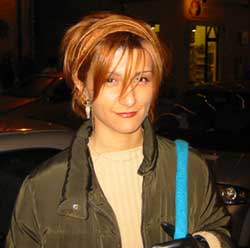 |
Networking women: an instance [1] Renata Morresi |
In this article I will follow a path of links, keywords and visual references to explore Life and Letters To-Day’s contribution to the cultures of modernism. This is only one of the several routes offered by the hypertextual database of the Networking Women project. Different types of search are possible: the starting point of the navigation can be a keyword (one’s pseudonym, the title of a journal, the name of a street, a salon, a year, a picture, a theoretical definition, etc.), but also one of the 16 subjects selected to focus on and redefine women’s spaces. The search does not direct one immediately to a document, but rather to a record of the document: what you read in the record is a detailed description and an interpretation of any chosen item (a photograph, a review, a letter, an index, but also a march, a performance, a social gathering, a definition, etc.). When it is possible, and if the copyright holder has given permission, documents are reproduced as attachments to the records. I encourage you to read the technical description of the project, the web site and the search engine that Tatiana Petrovich Njegosh has already provided in detail, in the “postcard” section of HOW2, n. 8, dated May 2002 (currently on-line).
“The underneath of history” is the way Nancy Cunard called what “has been in the records, all along, for all to see” but remained overlooked and unmarked. [2] I borrow her definition to describe the space in modernist cultural history that the Networking Women project is determined to explore and illustrate. The objective is to draw a map of the geography of networks created by modernist women, a territory in many ways still uncharted. We intend to walk around and bring to the surface what we can: those women, often forgotten, marginalized, ridiculed or erased (symbolically, think of H.D.’s name, but also physically, see Elsa Asenijeff’s confinement in a mental hospital), expand traditional notions of modernism in exciting ways, their work often overflowing the boundaries of genres and disciplines.
Bryher’s role as publisher and covert editor of the journal Life and Letters To-Day is an interesting case study. Bryher’s networks were not only webs of people, but moreover systems where ideas of modern culture were organic to the need to rethink and reform (just to name a few of her countless fields of interest) aesthetic theories, assumptions on gender roles, relationships between the sexes or the structure of the educational system. (See, for instance, her “The Best Years of One’s Life”). In Life and Letters To-Day the intention to create an international cultural network connecting writing, arts, science, social critique in a global scope was evident:
The world is narrower while knowledge is wider, and that the former be not destroyed, it is essential all branches of the latter be related. No one group, be it of artist or artisan, socialist or psychologist, painter, photographer or printer, can live in ignorance of implications of the other. [3]
Internationalism was the distinctive feature of the magazine, that was available all over the globe. (See where L&L was on sale). The scope of authors, travel writing, and reports from all over the world testifies to the attitude of its patroness: “All my life I have suffered from ‘geographical emotions’. Cities are so much easier to understand than people.” [4]
 |
Life and Letters To-Day aimed at becoming a centre for cultural debate on literature and the arts, promoting young talented writers, and, in general, at being a crucible for the new, which included new sciences such as psychoanalysis and anthropology and new arts such as cinema.
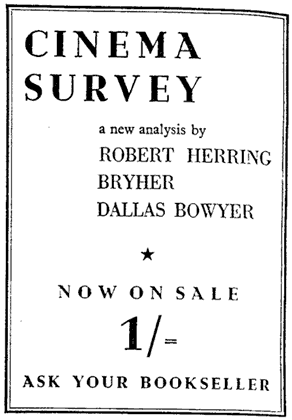 |
“To-Day” was added to the old title Life and Letters to emphasize the interest in everything contemporary: “We chose that word rather than ‘modern’ so as to be free of a time-label. Modern is often the mode of a yesterday that never had a to-morrow. To-day is continuous. [...] our main interest is with work looking forward”. [5] “To-Day” was meant to sponsor, together with an aesthetic vision organic to individual experience and socio-political history, the new lesson of the age: how to become modern. In Bryher’s view, attaining this temporal dimension meant blurring the boundaries of entities traditionally constituted as predetermined and impermeable. From the pages of Life and Letters To-Day she suggested the necessity to overcome the notion of gender difference for a more “modern” vision, moving beyond traditional boundaries between male and female. In a review of Richardson’s Clear Horizon she wrote:
It is perhaps a pity that Miriam should insist so often upon the classification of people into male and female, when modern discoveries show that in many respects the division must not be too rigidly made. It is however the logical outcome of Victorian training with its relegation of women apart from the favoured few, to the position of serfs. Yet for Miriam to accept the changed views of a post-war world might be to blunt this portrait of a truly pioneer generation. [6]
The magazine often dedicated a whole section to foreign literature translated into English (publishing, among the others, Kafka, Jean-Paul Sartre, and Ignazio Silone, or, for instance, dedicating whole issues to Chinese, Indian, Scandinavian literature), and, quite unusually for the time, occasionally presented reviews of translations as translations. (See the review of H.D.’s Ion) “[W]e ourselves, with our translations and articles on other countries, attempt to keep the world open.” [7] Life and Letters To-Day itself was an expression of Bryher’s intent to advance cultural work that produced fissures in the stable order imposed by traditional patriarchal narratives, allowing the passage of new meanings that could rip culture open, not only to include her and her circle’s priorities but also to redefine its very structure:
Arabic is a language of which we could scarcely understand less. So it was to our surprise that we found ourselves one night in October sitting in the Royal Egyptian Legation, listening to a lecture in Arabic on a poet of a thousand years ago. Our surprise was not lessened by a lady saying, as she took the next chair, “My husband would have been here but he’s in Lapland.” Her words brought yet another world into a room already containing several—robed gentlemen from Iraq walking with covered heads among chrysanthemums and rout chairs, beneath crystal chandeliers and other appurtenances of a West-end mansion with Dorchester House outside confusing us more with its suggestion of New York skyline. But we concentrated, observed the rhythms of Arabic, made mental notes of the apparent double layers of pitch and were rewarded, later, with translations. [8]
The author of this passage is not fascinated by the instrumental use of language, mere connecting tube between different mother-tongues, but rather by the potential offered by the co-presence of such a variety of cultures converging in one place and conversing with each other. Often represented as an epoch of fragmentation and alienation, certainly exacerbated by conflicts and innervated by imperialist will to power and anxiety over emerging cultural “others,” be it women campaigning for suffrage or colonial subjects demanding independence, modernism between the wars can also be visualised as a period of enthusiasm over technological innovations of means of transport, as instruments and symbols of cultural discovery, and over internationalism as one of the keys to progress. As Tatiana Petrovich aptly underlines, [9] Woolf in “Mr. Bennett and Mrs. Brown” purposefully gives her discussion over the making of the modern novel a moveable setting: the train, where the characters of the title are travelling from Richmond to Waterloo. Her vision connects the shifting values of modern reality to the possibility of change and to the progressive blending of public and private spaces.
The piece I’ve quoted from in Life and Letters To-Day strikes similar chords: its author highlights movement, relocation and displacement as the privileged lens for reading modernity, just as the intersection of different spaces becomes one of its inextricable qualities. What takes place in the text is both an emphasis on and a redefinition of space(s): a new relation of human beings to global space, a new relation of women to public space (not only can the lady attend the meeting without her husband, but we also find out later in the text that the reader of the poems is a woman herself), a new relation of British intellectuals to foreign ones—although their representation is certainly not free from exoticist attitudes, it seems at least aware of the other’s specific culture—and finally, a new relation to the constructed and derivative nature of any language rather of translation. Moreover, the author of the passage outlines a point that was further stressed by the journal’s editorial policy: the necessity of cultural multiplicity, travel and translation (travel as translation, and vice versa) to grasp modern reality and, if possible, to intervene in it and try to change it.
The journal had been started in quite a different tone. In a letter to Vanessa Bell dated February 1928 Virginia Woolf writes:
Desmond has been given £ 6.000 by Oliver Brett to start a monthly magazine with. How bored you would be to hear all of us authors chattering about it!—not that it will ever come out, but if it did come out it would be the most brilliant, the most advanced, the best said paper in the world—Also it would make Desmond’s fortune, so he says. [10]
The magazine indeed came out, it was called Life and Letters but its editor, Desmond MacCarthy, wasn’t greeted with the fortune he had expected. Life and Letters reflected MacCarthy’s interests in established British authors and detective stories and his personal connections with figures of the Bloomsbury set. After a few years the journal went through financial difficulties and MacCarthy had to leave his position; in April 1934 Hamish Smile took over as editor. He edited just one issue and in September 1934, when Constable and Company acquired the magazine, he was replaced by Ellis Roberts. Soon after Life and Letters was for sale again. Acquired by the Brendin Publishing Company, its name was changed into Life and Letters To-Day. Its headquarters were in Maiden Lane, central London.
The Brendin Publishing Company belonged to Bryher, but her connection to the magazine often goes unnoticed. Bryher (born Winifred Ellerman) is better known for being H.D.’s lifelong companion. Barbara Guest suggests that the review was bought by Bryher to provide H.D. with a place to publish her poetry and prose. [11] However, the thirties issues of the magazine presented hardly anything by H.D., aside from a handful of poems, while publishing a bulk of prose and criticism by Bryher herself. Robert Herring and Petrie Townshend were appointed as editors. Herring and Bryher had already worked together for Close-Up. Here is a picture of the two:
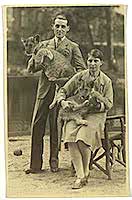 |
Petrie Townshend—editor with Herring for two volumes, but unmentioned in Guest’s paragraphs on the Life and Letters To-Day’s experience—was a long-time friend and a former school-mate of Bryher’s. In April 1935 she wired Bryher to inform her that Life and Letters was on sale for £1,500. Bryher was positively interested. She was in Kenwin, her Swiss residence, and had just come back from New York where she had collected enough writing to put two volumes together. She was too busy to edit the magazine personally, but she planned to hire somebody to do “the hackwork” while she would be in charge of the actual collection of manuscripts.
 |
Bryher contacted Robert Herring offering him the job of editor and asked Petrie Townshend to be the paper’s business manager. Townshend refused and asked for an editorial position. (See details on the acquisition of L&L) The first number of Life and Letters To-Day was issued on September 1935. Bryher’s influence on the magazine is evident, not only for the financial support she offered to it, but also because contributions and editorial slant were largely determined by her interests and personal connections. The first two issues of Life and Letters To-Day presented contributions by H.D., Mary Butts, Dorothy Richardson, and Gertrude Stein; all of whom had already been published by Contact Publishing Co., the publishing house directed by Robert McAlmon, Bryher’s first husband—who was to a large extent assisted by Bryher herself, though she preferred to stay out of the limelight. Among the contributors to Life and Letters To-Day we find several figures dating back to the Close-Up project, such as Oswell Blakeston, Barbara Low, Serghej Ejzentejn, Dorothy Richardson and other more or less intimate friends, like Sylvia Beach, Sylvia Dobson, Melitta Schmideberg, the psychologist, Kenneth Macpherson, Bryher’s second husband, Hanns Sachs, Bryher’s analyst, Havelock Ellis, with whom Bryher had a 20-year correspondence, and even 16-year-old Perdita, H.D.’s daughter adopted by Bryher.
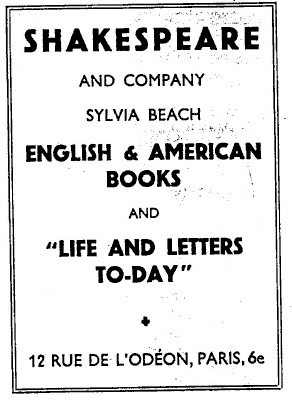 |
When, in The Days of Mars, Bryher writes about Life and Letters To-Day, she includes herself in the editorship of the paper:
It is difficult to understand the general boycott of Life and Letters To-Day by present literary historians of the period. Besides contributions from the Sitwells, H.D., Elizabeth Bowen, Dylan Thomas, Vernon Watkins, Alex Comfort and many other writers, we printed, I believe, the first story by Sartre to be translated into English and an early tale by Kafka. [12] (emphasis mine)
Bryher’s influence on Life and Letters To-Day was not limited to money and contacts, but she preferred to remain in the wings of the projects whose existence and success depended both on her patronage and on her active work. As a writer she contributed short-stories, criticism, reviews and comments; as editor she directed the magazine to represent her chief interests, such as psychoanalysis, cinema, travel writing, history, education, science and everything “new”: “A new period, in the art and letters with which we are primarily concerned, has long been discernible [...] and we feel ourselves suited to play a part in printing and recording whatever may be the best achievements of the new reign.” [13]
History does not occur—but it is often written—in decades. As Jane Dowson underlines in her book on women’s poetry of the thirties the notion of a decade as a category of literary analysis needs to be redefined since “it is its periodising impulse—in its insistence on ‘groups’ and ‘movements’—which is often responsible for excluding women.” [14] The British thirties are usually represented by a well defined group of young male poets who first used their craft to promote revolution and later disavowed both poetry and politics practiced in that phase. Usually defined as the age of ideology and realism, hostile to experimental writings or any indulgence in the inner self, and indifferent to race as an issue, the thirties are considered “a sort of unfortunate historical blip or bypass in which writing got snagged and slowed down in the good long march of the twentieth century from modernism at the beginning to postmodernism at the end.”[15] A monopoly on the decade has long been held by the so-called Auden generation, identified by Samuel Hynes in the homonymous book as a group of left-wing writers born between 1900 and 1914.[16]
This definition reinforces the image of a homogenous group of men whose work fully exhausts discussions of the age. A multitude of women is disqualified in a single blow, links and relations across countries and generations are erased. In fact, things were quiet different: for instance, women did produce as much political poetry as men and did show the same awareness and commitment that brought Hemingway and Spender to Spain. Nancy Cunard, Sylvia Townsend Warner, Valentine Ackland and Muriel Rukeyser, all of whom were published by Life and Letters To-Day, are among them. On the other hand some women writers were deeply involved in very different issues: “pure” aesthetics, experimentalism, introspection, autobiography, history and even sentimental writing. Among them were Bryher, H.D., Edith Sitwell, Elizabeth Bishop, Dorothy Richardson, Janet Adam Smith, Mary Butts, Marianne Moore, Marya Zaturenska, Pearl Buck, Barbara Low, Elizabeth Madox Roberts, Norah Hoult, Margaret Cole, Lotte Reiniger, Gertrude Stein, just to quote those who were (often) published and discussed in the pages of Life and Letters To-Day.
Possibly these women would not like to be “segregated” in a separate history, for two reasons at least: firstly, because most of them refused to be identified as “women writers” and rejected the need for such a category; secondly, because women and men were by and large involved in the same projects. As Lisa Rado well puts it: “[r]ather than frustrated prisoners of patriarchal law, these female intellectuals felt themselves to be at the forefront of a new era of possibilities for their sex, and worked tirelessly towards its realisation.” [17] But, as it is well known, while women’s cultural contributions have often gone unnoticed, their male counterparts have received disproportionate attention.
Though it published and reviewed a remarkable group of women poets and writers, Life and Letters To-Day didn’t profess any interest in women as a group to cherish or promote. The magazine was a site for debate, a public forum on crucial literary and social matters. It was acknowledged to be at the forefront in the promotion of left international anti-fascist culture and was considered “a sort of quarterly Left Review,” defined as such by The Criterion. The editors of Life and Letters To-Day must have agreed with the definition, since they published it as an internal advert. [18]
Left Review, the British journal closely allied with the Pro-Soviet Writers’ International, promoted revolutionary literature and had as its guidelines, as stated in the first issue in October 1934, anti-fascism, the development of a new socialist society and anti-imperialism. Life and Letters To-Day often published its adverts:
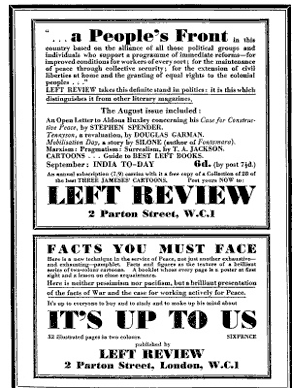 |
Unlike Life and Letters To-Day, Left Review published contributions directly dealing with feminism and women’s questions, such as “The Reluctant Feminists” by Naomi Mitchinson (December 1934), “Feminists and the Woman Question” by Philippa Polson (September 1935), and “Women in Scotland” by Willa Muir (November 1936). These debates didn’t arouse Life and Letters To-Day’s interest. The magazine didn’t champion an explicit gender or sexual politics, and indeed at first it embraced an idea of culture removed from all kinds of politics. In the first editorial of Life and Letters To-Day, in September 1935, we read: “[n]ow is not the time to talk of a brave new world, moreover we have eschewed politics.” A further analysis proves that things were quite different: considering what was published in the following pages the statement proves to be inaccurate. The issue presented an article by Havelock Ellis on Rousseau as forerunner of communism; a speech delivered by André Gide at the International Congress of Writers in Paris, where the French writer advocated communism as the “true defender of culture” and essential for the making of the “new man”; an article on Brecht; and one on war in South America. (See Contents L&L Sept. 1935) Life and Letters To-Day never advocated communist propaganda like Left Review, but it was undoubtedly left-wing. Throwing together Gide, Brecht, an article on war, Gertrude Stein on English and American language, and Horace Gregory on new American poetry, the journal indicated that between aesthetics and social-political realities no single dividing line could be drawn. Indeed the magazine’s name put “life” and “letters” on the same level, implying that each term resounded with the other. As the editors explicitly claimed in the summer 1936 editorial, the magazine addressed readers who “have room in their minds for social problems as for sonnets.” Nancy Cunard, who believed that revolutionary writers and poets had to share “the burdens, the problems, the tragedies of suffering humanity,” [19] was in tune with the stance adopted by Life and Letters To-Day. “Then, now—à la mode du temps—that the artist become the act”[20]: indeed during the summer of 1936 times had changed, especially in Spain. In the November issue of Life and Letters To-Day the editorial read like this:
…we expressed the intention of being non-political […] it would be useless to maintain now that Spain’s civil war is none of our business. It is everyone’s business. [21]
Cunard shared the position expressed in the editorial: in her first contribution to Life and Letters To-Day, a poem, she writes “All of it, all of it’s Spain.” [22] The rising of fascism in Spain was Cunard’s life-long torment and source of inspiration: she played a leading role in anti-fascist struggles, helping refugees, writing journalism, collecting funds and editing poetry. In 1937 she edited Authors Take Sides, whose advert appeared on the winter issue of Life and Letters To-Day. [23]
 |
The pamphlet-survey, edited by Left Review, collected 148 answers to the Question. On the Spanish situation, Life and Letters published several poignant stories and reports; among them “Barcelona, 1936” by Muriel Rukeyser. [24]
Bryher and Rukeyser not only shared a vivid interest in writing, but also, although they belonged to different generations, a passion for flying (see one of Bryher’s letters to Rukeyser). The excitement over adventure and travel was one of Bryher’s peculiar traits. Her “gestures of decentering” [25] were part of their quest for self-determination: refusal to be rooted in a given gender and sexual identity was also enacted through travel and relocation. The concept of travel as liberation shaped Bryher’s notion of aesthetic experience and surfaced in most of her writing: “[t]hus, to Nancy travel grew wonderful as a book, an inevitable thing, her proper heritage.” [26] It’s in her homage to Mary Butts however that Bryher finely describes the feeling of entrapment that she must have endured as a woman born in the Victorian age:
We were pruned of every form of self-expression, like the single flower on an exhibition stem, until everything in us went into a single desire, freedom, which we saw only in the wind or in the breaking waves and as we could not hold these, into what was nearest to them, poetry. […] It was, however, the sign of our age, the identification students will tag to us, when we are dug out, as the Elizabethans were in the nineteenth century, after the night of forgetting almost sure to come. [27]]
I suggest that here the limitations imposed on women are expressed not only in terms of a restricted physical and emotional space, but also as a motionless temporal dimension, devoid of the possibilities offered by the future. Possibly the origins of Bryher’s commitment to internationalism and “the new” ar inscribed in this passage.
Notes
[1] Part of this article will be
published in the forthcoming volume on Networking Women, proceedings
from the conference held in March, 25-26-27, 2002, Macerata, Italy. The
Networking Women website will be refurbished and some of the links
you find in this article might not be active in the near future: you will
be able to retrieve the documents by browsing http://reti.unimc.it.
[2] Nancy Cunard, “Proclamation of
Emancipation of the Slaves. Abraham Lincoln,” in Negro: an anthology
made by Nancy Cunard, 1931-1933, Wishart & Co., London,
1934, pp.20-21.
[3] “Editorial,” Life and Letters
To-Day 14.4 (Summer 1936), p.2.
[4] Bryher, “Paris, 1900”. Life
and Letters To-Day 16.8 (Summer 1937), p.33.
[5] “Editorial,” Life and Letters
To-Day 13.1 (September 1935), p.1.
[6] Bryher, Review of Clear Horizon
by Dorothy Richardson. Life and Letters To-Day 13.2 (December 1935),
p.199.
[7] “Editorial,” Life and Letters
To-Day 15.5 (Autumn 1936): 3.
[8] “Al-Moutanabby’s Millenary,”
Life and Letters To-Day 15.6 (Winter 1936): 5.
[9] Tatiana Petrovich Nijegosh, “Making
Modern Women: Modernist Freewomen between Public and Domestic Space in
Edwardian London” in Networking Women, forthcoming.
[10] Virginia Woolf, Letter to
Vanessa Bell, 11 February 1928. A Change of Perspective: The Letters
of Virginia Woolf, 1923-1928. Vol. III. Ed. Nigel Nicolson. London:
The Hogarth Press, 1977, p.457.
[11] “If H.D. were worried about
her neglect by the literary scene (and this was not an unreal fear, for
recently she had indeed been excluded by Robert Graves and Laura Riding,
who disliked imagism), Bryher would provide a publication in which H.D.’s
poetry and prose could once more find its readers.” Barbara Guest, Herself
Defined: The Poet H.D. and Her World. New York: Doubleday, 1984, p.232.
[Editor’s note: a paperback reprint of this book will soon be available
from the Schaffner Press (Tucson).]
[12] Bryher, The Days of Mars.
A Memoir. 1940-46. London: Calder & Boyars Ltd., 1972, pp.32-33.
[13] “Editorial”. Life and Letters
To-Day 14.3 (Spring 1936), p.1.
[14] Jane Dowson, “Introduction”.
Women’s Poetry of the 1930s. A critical anthology. Ed. Jane Dowson.
London and New York: Routledge, 1996, p.3.
[15] Valentine Cunningham, “The
Age of Anxiety and Influence; or Tradition and the Thirties Talent.” Rewriting
the Thirties: Modernism and After. Eds. Keith Williams and Steve Matthews.
London and New York: Longman, 1997, p.5.
[16] On this point see also Ornella
De Zordo, “London 1920s: Time and Tide Wait for No Man” in the forthcoming
volume on Networking Women.
[17] Lisa Rado, “Introduction”.
Modernism, Gender and Culture, p.11.
[18] See Life and Letters To-Day
17.9 (Autumn 1937), p.viii.
[19] Nancy Cunard, “Three Negro
Poets”. Left Review 3.9 (October 1937), p.535.
[20] Nancy Cunard, “Yes, It Is
Spain”. Life and Letters To-Day 19.13 (Autumn 1938), p.58.
[21] “Editorial”. Life and Letters
To-Day 15.5 (Autumn 1936), p.1.
[22] Nancy Cunard, “Yes, It Is
Spain”. Life and Letters To-Day 19.13 (Autumn 1938), p.58.
[23] Life and Letters To-Day
17.10 (Winter 1937), p.203
[24] See Gigliola Sacerdoti Mariani’s
essay on Muriel Rukeyser in this issue of How2.
[25] Margaret Dickie and Thomas
Travisano, Gendered Modernisms: American Women Poets and Their Readers.
Philadelphia: University of Pennsylvania Press, 1996, p.viii.
[26] Bryher, Two Novels: Development
and Two Selves, p. 25.
[27] Bryher, “Recognition Not Farewell.”
Life and Letters To-Day 17.9 (Autumn 1937), p.161.
BIO: Renata Morresi is PhD candidate in Comparative Literature and Poetry at the University of Macerata, Italy, where she is involved with teaching activities in Anglo-American Literature. She is working on a doctoral thesis on Nancy Cunard and her cultural and political networking. Morresi has translated and written on Nancy Cunard, little literary magazines of the ’30s, Zora Neale Hurston, black American autobiography and American women’s poetry in relation to myth. She is involved in the organization of poetry contests, readings and performances and is herself a poet.
go to this issue's table of contents